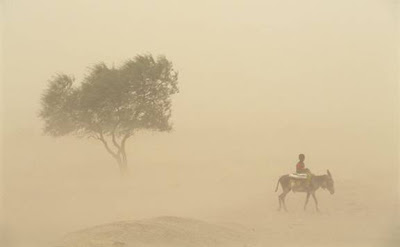
 Here in western Canada we don't think we have dust storms but that is not quite true. The Sahara desert is the birth place of the largest dust storms and sometimes this dust goes twice around the world. So the whole world gets dust from these storms.
Here in western Canada we don't think we have dust storms but that is not quite true. The Sahara desert is the birth place of the largest dust storms and sometimes this dust goes twice around the world. So the whole world gets dust from these storms. As you can see from the pictures these storms can ruin your day. They also remove millions of tons of topsoil because the topsoil is the lightest type of dust. The cause huge cleaning bills in areas where the dust is bad. They can transmit viruses over long distances. They are hard on machinery and other mechanical devices, like computers and they are increasing world wide.
The bottom pictures shows Australia where dust storms have increased significantly over the past decade. Sydney Australia had two serious dust storms in the last month. Visibility in the city at that time was less than one mile.
 China has had more dust storms and these are blamed on poor forestation and farming practices in large parts of China.
China has had more dust storms and these are blamed on poor forestation and farming practices in large parts of China. In spite of this increase in storms governments around the world still promote the cutting of forests while doing little to reforest newly created deserts.







 The World Bank is spending billions of dollars subsidising new coal-fired power plants in developing countries despite claiming that burning fossil fuels exposes the poor to catastrophic climate change.
The World Bank is spending billions of dollars subsidising new coal-fired power plants in developing countries despite claiming that burning fossil fuels exposes the poor to catastrophic climate change.











